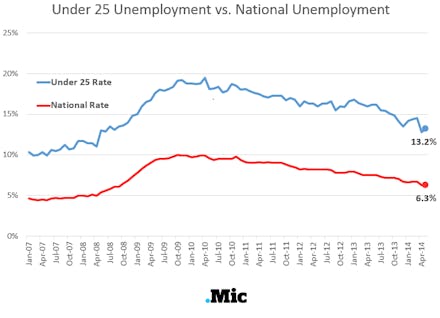What Parents Need to Understand About Being Young Today, in 8 Charts

There’s a simple reason young adults are living at home in higher numbers: For many, moving out means living in poverty.
The numbers are jarring. According to the Pew Research Center, a whopping 56% of 18-24 year olds lived at home in 2012, the highest rate since the 1970s. Today’s young adults are taking longer to reach life milestones like taking out a mortgage or getting married. The New Republic has dubbed this trend the Great Delay.
Popular theories about why our generation lives at home end up incorrectly psychoanalyzing young adults. Young people were praised too much as children. They’re addicted to social media. They feel entitled to the perfect job.
It’s not a matter of laziness or entitlement. Anyone who blames young adults for moving back home is missing the obvious reason: the terrible economy. The reality is that many young adults would be living in poverty if they weren’t living at home.
To see why, focus on the young people who have moved out.
Over 4.6 million adults under age 25 are “householders,” according to the U.S. Census, meaning they either rent or own a place in their name. Their lives are incredibly challenging — constrained by low incomes, high living costs and high debt — making the option of moving back home alluring as ever.
1. On average, under-25 households are the poorest.
Data from 2012 American Community Survey (ACS). Chart by Chris Walker.
While older households cluster around middle-class incomes, more than 40% of young households (headed by someone under 25) earn less than $20,000 per year.
2. Under-25 poverty rates are incredibly high.
Data from 2012 ACS. Chart by Chris Walker.
This is the reality most young adults grapple with upon deciding whether or not to live with their parents.
3. Young unemployment is more than double the national average.
Data from Bureau of Labor Statistics. Chart by Chris Walker.
Many young adults, whether they’re living with their parents or on their own, struggle to find work. The unemployment rate for young adults (13.2%) has come down from it’s peak (19.5%), but it’s still higher today that it was before the recession.
And those who do manage to find work are faced with stagnant hourly wages.
4. Under-25 wages are lower than 10 years ago.
Dollar figures adjusted for inflation using Consumer Price Index, presented in 2014 dollars. Wage data from Bureau of Labor Statistics. Chart by Chris Walker.
After adjusting for inflation, young workers today earn 45 cents less per hour on average than young workers did in 2004.
5. Almost 9 out of 10 young householders are renters.
Data from 2012 ACS. Chart by Chris Walker.
6. High rents hit young people the hardest.
Rent burns through a huge chunk of young renters’ tiny incomes.
Data from 2012 ACS. Chart by Chris Walker.
The high rent-to-income ratio helps explain why young renters are financially fragile, and why so few of them can even think about saving for retirement.
7. College debt impacts 43% of young households.
In addition to low incomes and high rents, many young householders also carry severe student debt burdens.
Chart by Chris Walker. Data from Pew Research.
The corollary to the chart above is that a significant number of young households have at least some college education. In other words, young householders aren’t just deadbeats who were forced to move out by their parents.
While it’s great that more young adults than ever are pursuing a college education, they’re doing so at a greater and greater cost. The average student debt load per borrower has been rising rapidly over the past 20 years.
8. Recent graduates have record-breaking student debt.
Chart from the Wall Street Journal.
It takes years, perhaps decades, to pay off debt at this scale. Even if the borrower makes payments on time, the large amount of student debt will make it harder for borrowers to gain approval for other types of loans, such as for a car or house.
The struggle is real. Young adults face an economic trifecta of low incomes, high living costs and high debt. The next time someone tries to slap a demeaning label like “boomerang kid” — or even worse, “twixster” — on young adults living at home, show them these eight charts.